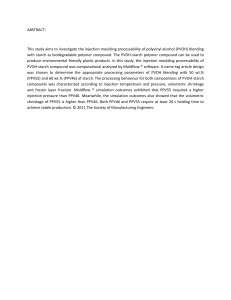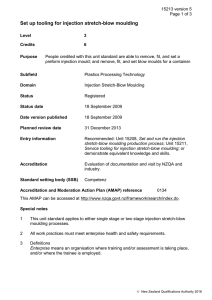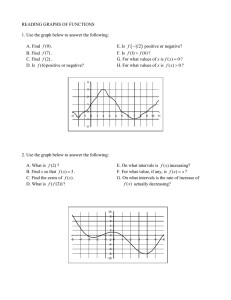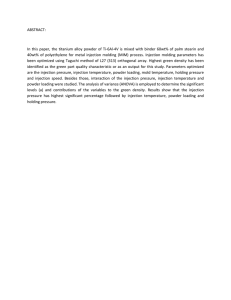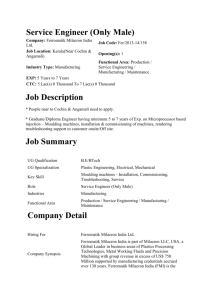Powder injection moulding
advertisement
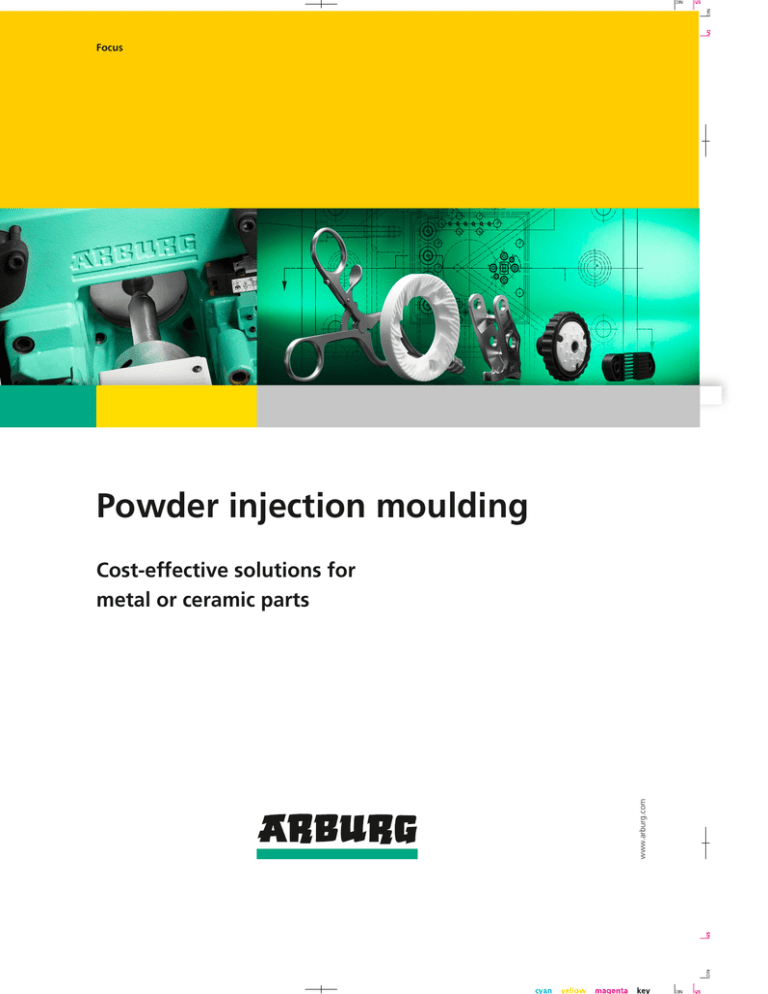
Focus Powder injection moulding www.arburg.com Cost-effective solutions for metal or ceramic parts At a glance Example: burner for HID bulbs. Ceramic injection moulding enables the efficient production of smaller parts with equal performance. The need for highly resilient and precise components is growing in virtually all industrial sectors. With the injection moulding of powdered materials (PIM) you have access to a technology that offers new design options for highly complex components made from metal (MIM) or ceramics (CIM). Consistently high-quality parts with details down to the micrometer range can be produced in high volumes. The great advantage: freedom of shape. Like no other process, powder injection moulding enables near-final-contour part production, including internal threads, difficult undercuts, gearings and free-form surfaces. PIM parts display mechanical and material properties which are comparable to those of conventional metal and ceramic parts. Technology of the future with high added value – so why not benefit? 2 Expert consulting throughout the entire process chain Powder Feedstock Binder Feedstock preparation Green compact Injection moulding Brown compact Debinding Breaking sprues Finished part Sintering Reworking Unique ARBURG service range www.arburg.com · 012016 Example: laptop catches. Through the use of metal injection moulding, highly resilient components can be produced in any shape for high-volume production. Exploiting injection moulding potential PIM technology enables the production of complex parts in high unit volumes. The production process can be highly automated, production can be quickly converted to other products. ARBURG injection moulding technology is equally flexible: • with the modular range of hydraulic and electric ALLROUNDERs • with application-specific equipment versions, e.g. for multi-component technology • with the appropriate PIM-specific adaptation of the injection units in terms of geo­ metry and wear resistance As a result and through close co-operation with the leading material, mould and furnace technology manufacturers, ARBURG develops optimum, customised, user-specific solutions. 012016 · www.arburg.com Reliably achieving quality With the freely-programmable SELOGICA control system on each ALLOUNDER, PIM processing can be implemented for maximum quality long-term. This is ensured, not only thanks to the position-regulated screw, but also to the fully integrated robotic technology for gentle handling of the fragile moulded parts, the so-called “green compacts”. Functions such as compression injection moulding and evacuation also ensure a high level of process stability and repeat accuracy. The graphic symbols as well as the direct plausibility checking during sequence programming permit a good overview, and ensure simple setup of even complex production processes. Moreover, numerous options are available for optimising, monitoring and documenting production processes. Reliance on comprehensive support ARBURG is also a pioneer on the market for powder processing. Customers can rely on the corresponding comprehensive consulting, technology and service offerings throughout the process chain This is ensured by a cross-departmental team of PIM specialists who have already set up several hundred systems world-wide. The support offerings range from material selection and preparation, moulded partcompatible design, individual machine and mould configuration, through to the debinding and sintering process. Whether for process optimisation, material or mould testing: At ARBURG’s in-house powder laboratory, customer-specific tests can be performed and sample parts produced. Indepth training courses complete the unique range of services. 3 Multi-stage: the manufacturing process Nominal dim. mm Tolerance +/- mm+/- <3 0.05 3-6 0.06 6-15 0.075 15-30 0.15 30-60 0.25 >60 0.5% of nominal dimension Extremely precise: meeting the strictest tolerances Perfect preparation: powder properties decisive Precise contours: injection moulding key to subse- with powder injection moulding. for process and component. quent part quality. Machining technology? Stamping technology? Your product ideas can no longer be implemented cost-effectively in high unit volumes using conventional production methods. It therefore makes sense to take a closer look at powder injection moulding. With this alternative method, you have almost unlimited design freedom with regard to your components, generate virtually no waste and achieve a high degree of surface quality as well as dimensional stability. Time and cost-intensive reworking of parts is dispensed with. Your production becomes highly economical and efficient through the comprehensive linkage of all process steps. You thus produce your PIM parts just as you always expect to: reliably, flawlessly and smoothly. Feedstock preparation: mixing powder with binder In principle, all fine-grained, sinterable powders can be mixed with a suitable polymerbased binder and then processed on injection moulding machines. During mixing, the binder and powder are mixed to a homogeneous compound, the feedstock. The selection of powder materials is extensive: In addition to the oxide ceramics and steels, hard and precious metals as well as cermets can also be used. Material manufacturers supply a steadily growing selection of injectable feedstocks for metals and ceramics, including magnetic versions, for example. Furthermore, customer-specific feedstocks can also be developed and produced. Injection moulding: moulded part manufacture For the injection moulding of powder materials, similar mould and process technology is used as that for plastics processing. The binder content of the feedstock is melted in the plasticising unit through heat before being injected into the mould at high pressure. Robotic systems are generally used to remove the hardened moulded part, the socalled “green compact”, from the mould without damage. Material and mould changes can be performed in a short time. “Just in time” production can be easily implemented, as can unmanned volume production using the appropriate automation solutions. 4 www.arburg.com · 012016 PIM laboratory In order to demonstrate the complete powder processing procedure to interested parties in practice, ARBURG has a unique PIM laboratory. Individually debinded: in suitable atmosphere, High-quality sintering: moulded parts shrink iso- dependent on binder and moulded part. tropically, i.e. equally in all directions. Debinding: removing polymer During debinding, the polymer component is removed from the green compact using either a catalytic process, dissolving (e.g. with water or acetone), or thermal decomposition. This process can be effectively supported by suitable process control measures. When the binder is removed, the moulded part becomes what is known as a “brown compact”. In this condition, the parts are porous, fragile and relatively unstable. The debinding system must be adapted to the specific binder system employed. Sintering: mechanically stable bonding In order to securely bond the particles of the brown compact, the part is sintered by further heating. For this purpose, a certain furnace atmosphere and temperature-time profile must be maintained. The final moulded part, which becomes denser by 15 to 25 %, is produced by diffusion and/or the formation of liquid phases and grain growth. Injection moulded, sintered parts are characterised by great homogeneity and high material density. Fine powders and suitable mould technology ensure outstanding surface qualities and minimal tolerances. 012016 · www.arburg.com Here, all the steps from feedstock mixture, preparation and injection moulding through to debinding and sintering of the moulded parts can be carried out under laboratory conditions. In-depth consulting by experienced specialists is also available – on suitable powder/binder mixtures, for example, on green compact production, on downstream processes, as well as on machine and mould design. A variety of test parts can be injection moulded on in-house moulds. ARBURG also develops and tests feedstock mixtures for customers. In order to optimise the feed characteristics, the feedstock can be processed into a homogeneous granulate. Finally, the PIM laboratory is equipped with the necessary facilities in order to perform all the debinding processes currently available on the market. 5 Unlimited: the possibilities of modular machine tec Effective savings: short sprues thanks to extended nozzle length. Highly wear-resistant: powder-compatible nonreturn valves. The injection moulding of ceramic or metal powders does not differ significantly from the processing of filled plastics. This especially applies to consistently high quality during volume production. Faults in the moulded part such as cracks, for example, can no longer be remedied during subsequent debinding and sintering. We consequently place great value on reproducible, flawless injection moulding production. Only then can you as a PIM producer be on the safe side and smooth-running production be ensured. Basis: repeat accuracy Thanks to three-platen technology, clamping units with four tie-bar guidance and central force application, as well as servo-regulated mould movements, the clamping units ensure precise moulding, protection of the mould and precise positioning. The high-precision technology effectively counteracts burring. Depending on the requirements, hydraulic or electric machine options can be used. Reproducible mould filling and particularly high moulded part quality are achieved by means of the unique position regulation of the screws. This minimises rejects. Important: adapted plastification With ARBURG, the non-return valve can be configured according to the relevant particle size of the powder, ensuring a high degree of process stability, even in the case of coarse powders. The geometry of the PIM screws is always designed for the necessary low compression. Overheating and decomposition of the feedstock is thus reliably prevented. Effective powder processing Sprues are kept short through extension of the PIM nozzle length. The expensive feedstock is optimally utilized and the moulded parts are always perfectly compressed. Owing to the abrasive properties of the powder/binder melt, the injection unit is designed to be extremely wear resistant. Cost-effective operation with short setup times is also important in the case of complex production processes. On the ALLROUNDERs, this is achieved through the simple replacement of the cylinder module and screw via the swivelling injection unit and the central coupling of all the supply connections for the cylinder module. Further information: Hydraulic ALLROUNDERs brochure Electric ALLROUNDERs brochure 6 www.arburg.com · 012016 chnology PIM package ARBURG has combined the necessary basic equipment for optimum processing of powder materials into one package. As standard this includes: • MIM or CIM cylinder module with specific configuration of the non-return valve • Extended PIM nozzle length • Position-regulated screw • Additional nozzle heater circuit • Interfaces for vacuum devices • SELOGICA functional expansions Custom adapted: mould venting with modular Careful handling: gentle part removal with vacuum technology. robotic system. Wide variety of options In principle, all ALLROUNDERs are suitable for powder processing. The machines can be individually adapted with a • variety of hydraulic expansion stages • flexible combination of injection and clamping units • various injection unit arrangement options – e.g. for multi-component injection moulding • task-specific equipment packages – e.g. for gas injection moulding technology or in-mould lamination of green sheets. Complete solutions precisely adapted to the applications are created by means of integra­ ted peripherals and automation solutions, for part removal and set-down, for example. 012016 · www.arburg.com There are also additional expansion options. These include: • Vacuum devices • Robotic systems with various kinematics • Universal compression injection moulding via ejector or core pull 7 Suitable for all requirements: the SELOGICA control 1 Reliable evacuation One important technique for powder processing is venting of the mould prior to injection. This prevents air inclusions, joint line problems and binder migration, as well as ensuring complete mould filling with uniform filling characteristics. Venting can be programmed with great flexibility via dedicated symbols, whereby integration of all common vacuum concepts is possible. Moreover, SELOGICA also utilises signals from vacuum devices for process and quality control. This ultimately results in the transparent control and documentation of the entire venting process directly on the control screen. User-friendly: simultaneous monitoring of robot and machine sequence. Maintaining control over sophisticated machine, mould and robotic technology is the domain of SELOGICA. With this setting and monitoring system, you can quickly set up both simple and complex injection moulding processes, operate them intuitively and perform reliable optimisation. In other words: central management. All technical features of the SELOGICA control system, such as the graphical sequence editor, are also ideally suited for the processing of powder materials and aimed at making operation quicker, more reliable and more convenient. Here too, ARBURG provides you decisive application advantages: because we have already integrated all the necessary functions for high-quality and cost-effective part production in the SELOGICA system. 1 Further information: SELOGICA control system brochure 8 www.arburg.com · 012016 Highlights system 2 Universal compression injection moulding One important function for directed mould filling without the formation of open jets is compression injection moulding. Here, the ejector or core pulls are actively moved during injection. The compression sequence is both controlled and freely-programmable via SELOGICA, for example through individual selection of the starting conditions. Fully integrated peripherals Reliable evacuation 3 Fully integrated peripherals The SELOGICA central control system integrates all the necessary peripherals, for example robotic systems. To ensure particularly gentle part handling, all processes can be programmed as a function of and synchronously with machine movements. As part of the overall sequence, they appear with dedicated symbols in the sequence editor and can be centrally monitored. • Control centre for the entire injection moulding technology • Convenient sequence programming with graphic symbols • Immediate plausibility checks • Freely programmable production sequences • Common data record for the entire production unit • Water-cooling for continuous temperature control in the control cabinet 3 2 Universal compression injection moulding 012016 · www.arburg.com 9 Application examples 1 2 Dependability: stable and reliable volume production with PIM system solutions from ARBURG. Utmost precision: injection moulding of ceramic ferrules to meet the sharpest of tolerances. Due to the high degree of design freedom with regard to the parts, the wide range and combination of different materials and, above all, the costeffectiveness of the production process, powder injection moulding is an ideal process for reliably and effectively manufacturing complex components from metal (MIM) or ceramics (CIM). Furthermore, technologies such as multicomponent injection moulding extend the range of possible applications. In addition to our innovative and sophisticated technology, from the standard solution to the system solution, you can also rely on our extensive expertise in applications technology. Whenever you need it. However you need it – for the best, most cost-effective solutions. 10 1 MIM for combustion engines One example of the high performance now achieved in the injection moulding of metallic powder materials is demonstrated by the high-toughness, high-strength intermediate lever arm used for valve actuation (Valvetronic) in a six-cylinder BMW engine. This particular production example very clearly illustrates the benefits of the ALLROUNDER injection moulding technology. The production process runs extremely smoothly and very reliably, even during shift operation. This enables high-quality zero-faults production. The injection unit is adapted to the specific requirements of the MIM process. A highly competent Service department, which is available at short notice, completes ARBURG’s service offerings. 2 CIM with minimal tolerances Ceramic ferrules are used for connecting optical fibre bundles for data transmission. The concentricity and the highly accurate drilling of the through-hole measuring just 0.125 mm is a decisive factor with respect to the quality of the components. In comparison to other production processes, the ferrule can be manufactured with a higher degree of precision when powder injection moulding with a hydraulic ALLROUNDER is used. This application allows ARBURG’s position-controlled screw to demonstrate its full potential. Tolerances of ±10 μm are possible for concentricity, whereby the finishing work is reduced to a minimum. Part removal via the MULTILIFT H robotic system delivers additional process reliability. www.arburg.com · 012016 3 4 5 Three-fold combination: several materials can also Great freedom: feedstocks can be individually Red hot: the material properties are only achieved be processed simultaneously. developed and injection moulded. during sintering. 3 4 5 Articulated metal joint Multi-component injection moulding also enables the combination of different powder materials in a single component. Here, the different shrinkage characteristics of the materials during sintering are exploited in order to produce permanent, moveable connections that could not be manufactured by conventional means. The ball joint is produced on a three-component ALLROUNDER. Here, the third component only serves to support the green compact and is removed following sintering. The three injection units, as well as all mould and robotic sequences can be fully integrated into the central SELOGICA control system. 012016 · www.arburg.com Ceramic grinding disc The efficient production of technical ceramic parts, grinding mechanisms for example, can be implemented using powder injection moulding. More stringent tolerances can be met with regard to the injection moulded parts, reducing the amount of coffee required for each cup. In order to produce the ceramic grinding discs, the melted feedstock is injected into the mould using a staged injection profile. The parameters are specially adapted to the component being produced. A MULTILIFT robotic system removes the grinding discs and sets then down onto the debinder and sintering trays in a specified pattern. The total cycle time is between only 15 and 25 seconds. Hard alloy radius milling cutter Only with powder processing can hard alloy cutting tools be produced without restrictions in terms of moulded part geometry. Injection moulding enables the trouble-free production of hard alloy cutters, including simultaneous demoulding of an internal thread for screwing the “disposable tips” onto a shaft. Fully automatic production is possible, saving time and expense. Owing to the very short sprues, considerable material savings are also achieved. A wide variety of cutting geometries can be produced in the mould by simply changing replaceable inserts. Thanks to the PIM process, only regrinding of the seats and cutting edges is necessary. 11 Distances between tie bars from 170 x 170 to 920 x 920 mm | Clamping forces from 125 to 5,000 kN | Injection units from size 30 to 4600 (according to EUROMAP) ARBURG GmbH + Co KG With locations in Europe: Germany, Belgium, Denmark, France, United Kingdom, Italy, Netherlands, Austria, Poland, Switzerland, Slovakia, Spain, Czech Republic, Turkey, Hungary | Asia: People’s Republic of China, Indonesia, Malaysia, Singapore, Thailand, United Arab Emirates | America: Brazil, Mexico, USA For more information, please go to www.arburg.com. © 2016 ARBURG GmbH + Co KG The brochure is protected by copyright. Any utilisation, which is not expressly permitted under copyright legislation, requires the previous approval of ARBURG. All data and technical information have been compiled with great care. However we accept no responsibility for correctness. Individual illustrations and information may deviate from the actual delivery condition of the machine. The relevant valid operating instructions are applicable for the installation and operation of the machine. ARBURG GmbH + Co KG DIN EN ISO 9001 + 14001 + 50001 certified 522785_EN_GB_012016 · Subject to alterations Printed in Germany Postfach 11 09 · 72286 Lossburg · Tel.: +49(0)7446 33-0 · Fax: +49(0)7446 33-3365 · www.arburg.com · e-mail: contact@arburg.com
